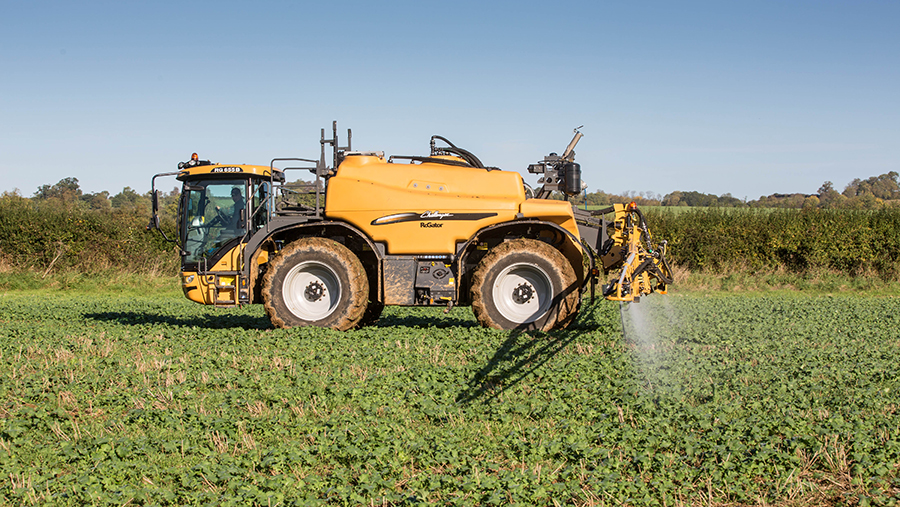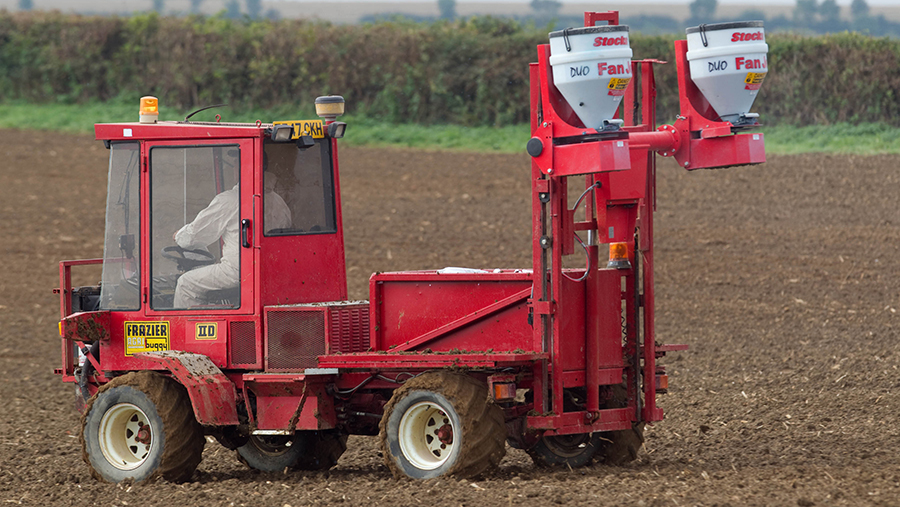Rule reminder: Key pesticide stewardship guidelines
 © Tim Scrivener
© Tim Scrivener Pesticide stewardship campaigns are now at the heart of industry efforts to prevent further losses of under-threat active ingredients.
Here, we give a reminder of the stewardship guidelines or information available to help mitigate the risk of problems arising from the use of some key actives currently in the spotlight.
See also: How on-farm weather data can improve crop management
1. Nematicides
Granular nematicides play a vital role in controlling soil-borne pests in potatoes and other root crops and the Nematicide Stewardship Programme (NSP) aims to promote responsible and sustainable use and protect operators, the environment and consumers.
The initiative brings together manufacturers Corteva and Syngenta and is supported by several industry bodies, including the AHDB, AIC and NFU.
Applying granular nematicides in line with the NSP best practice protocol became part of the audited Red Tractor standards for fresh produce, combinable crops and sugar beet in October 2019.
Best practice can be summarised as follows:
Qualify
Operators who are planning to apply nematicides must be PA4 or PA4G accredited and also be a member of the National Register of Sprayer Operators.
Alternatively, growers can complete specific training on nematicide application through Artis stewardship training. This can be done online through a new e-learning module, which includes a printable certificate to show at a Red Tractor inspection.
Calibrate
Granular applicators should be checked before the start of the season and on each working day, to ensure that all pipework is correctly fitted and the hopper bungs are in place and hopper lids are secure.
When the applicator is in use, granules should also be monitored to check they are flowing correctly.
The applicator must also be inspected and certified by a National Sprayer Testing Scheme-qualified engineer every year.
Single pass
All granular nematicides should be applied and incorporated within a single pass immediately before planting, with no granules left on the surface.
Shut-off
All applicators must be fitted with a device in the cab that allows the operator to shut off the granule flow before the end of each row.
For potato growers, shut-off must be achieved at least 3m from the end of each row. All growers should be mindful of the delay between shut-off and granules clearing the outlet.
Applicators that were produced prior to 2017 will not necessarily already have the capability to meet the new standards, but all applicators which are on-farm can meet the standards, with several options being open to growers.
Approved systems include manual shut-off using an electric or cable clutch, or a hydraulic land wheel lift.
An electric or hydraulic drive can also be used, and has the additional benefit of auto rate control and record-keeping, which can be used by growers to prove their applied area.
Alternatively, operators can harness existing technology already built into their tractors by using GPS and uploading pre-formulated maps, which means shut-off will be automatic.
Spillages
Hoppers should be filled within designated sites that can easily be checked for spillages.
Small spillages should be buried immediately, ensuring that no granules are left on the surface.
Larger spillages should be removed into an empty nematicide container, clearly labelled and returned to the manufacturer.
Check
Monitor treated fields 24 hours after application for any adverse effects on wildlife.
If any are found, growers should contact Natural England’s Wildlife Incident Investigation Scheme on 0800 321600, and the product manufacturer.
More detail on each aspect of the best practice protocol can be found on the Nematicide Stewardship Programme website, where there is also a handy video guide to applicator calibration.
2. Oilseed rape herbicides
There are five oilseed rape herbicide actives that are vital to keeping crops free from weeds, but with many post-emergence applications applied late in the autumn, there is an increased risk of contaminating groundwater.
Agrochemical manufacturers BASF and Adama teamed up to implement the “Metazachlor Matters” campaign, which raised awareness of issues relating to metazachlor and quinmerac applications.
Guidance on these two actives remains unchanged (see below), but stewardship advice is now included in the Voluntary Initiative’s “OSR Herbicides? Think Water” campaign, along with three other actives – propyzamide, carbetamide and clopyralid.
Metazachlor and quinmerac stewardship guidelines
- Maximum dose – 750g/ha metazachlor and 250g/ha quinmerac
- Where there are no drains – no timing restrictions
- For drained fields (including temporary) – aim for 1 October application; cut-off date is 15 October
- Applications after 1 October can be made if soil/seed-bed conditions are good and drains not flowing
- Drained fields in drinking water safeguard zones – cut-off 1 October
Of the five actives, propyzamide is most frequently detected, while quinmerac and clopyralid are the most difficult for water companies to remove from raw water supplies.
The campaign outlines five steps that oilseed rape growers can follow to help minimise the risk of the five herbicides being detected in water.
Use the Environment Agency’s “What’s in your backyard?” tool to find out if your land is in a drinking water safeguard zone and understand the pesticides that are of specific concern
If you are farming in a drinking water safeguard zone, speak to your local water company catchment officer to understand the potential risk on a field-by-field basis, or speak to your agronomist
Further to this, growers should implement best practice agronomy to help protect water by:
- Managing tramlines, pathways and gateways to minimise compaction and reduce the risk of surface water run-off.
- Ensure all surface water adjacent to oilseed rape fields is protected by at least a 6m vegetative buffer strip.
- Before making applications, always refer to product-specific labels and the Voluntary Initiative’s water protection advice sheets.

© Tim Scrivener
3. Bentazone
Bentazone is a herbicide familiar to pulse, linseed and potato growers, but Environment Agency data shows it is the most frequently detected approved pesticide in UK groundwater. It is also increasingly being found in surface water.
Due to the link between EU legislation on pesticides and water, it is possible that the EU approval for bentazone will not be renewed, resulting in the loss of all bentazone products across Europe.
BASF’s Bentazone Water Stewardship Programme is a proactive initiative aimed at encouraging responsible product use.
The Voluntary Initiative’s water protection advice sheet for bentazone was updated in 2019 to reflect BASF’s recommendations.
The advice is as follows:
- Do not apply if heavy rainfall is likely within 48 hours.
- Avoid application when drains are flowing or are likely to flow within seven days.
- Reduce dose rates (≤1,000g/ha/year) as far as possible
- Use bentazone as late as possible to reduce leaching probability; do not apply in autumn/winter.
Follow basic water protection advice
- Point pollution sources (farmyard runoff, spillages) must be avoided.
- Take care when filling and cleaning the sprayer.
- Use a minimum 6m grass buffer strip or 5m no-spray zone adjacent to watercourses.
- Do not apply if soils are dry, cracked or saturated.
Bentazone use advice at a glance |
|||
|
|
High-risk areas* |
All other areas |
|
|
Soils |
Shallow and stony soils on chalk/limestone |
Do not use |
Avoid use |
|
Shallow soils on sandstone |
Do not use |
Avoid use |
|
|
With shallow groundwater |
Do not use |
Avoid use |
|
|
With low organic carbon (<1%) |
Do not use |
Avoid use |
|
|
Other soils |
OK to use |
OK to use |
|
|
Timing |
Spring and summer |
OK to use after 1 April |
OK to use |
|
Autumn/winter |
Do not use |
Do not use |
|
|
Rate |
All soils |
Do not use more than 1,000g/ha/year of active |
Avoid use of more than 1,000g/ha/year of active |
|
*High-risk areas include drinking water groundwater safeguard zones (for bentazone or nitrates) and groundwater source protection zones 1+2. |
|||
Metaldehyde stewardship
While metaldehyde slug pellets are being phased out, farmers still need to follow the enhanced metaldehyde stewardship group guidelines.
Metaldehyde slug pellets cannot be sold after 31 March 2021 and farmers will have 12 months to use up stocks before the 31 March 2022 ban.
In this period, farmers need to follow these guidelines:
- No pellets to be allowed to fall within a minimum of 10m of any field boundary or watercourse.
- Use minimum active per hectare to avoid drainage and run-off losses.
- Maximum total dose from 1 August to 31 December: 210g metaldehyde/ha. For additional protection of water, suppliers/Basis advisers may recommend rates reduced to 160g/ha or less.
- Maximum total dose rate: 700g metaldehyde/ha/calendar year.
- Do not apply when heavy rain is forecast.
- If drains are flowing, do not apply metaldehyde-based slug pellets.

